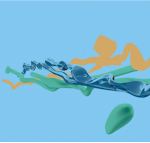Students from music production have been collaborating with creative director Patric Sarin from Warner/HMC publishing. Sarin has been in the business for 17 years and believes in helping the students prepare for the outside world. The students are working in groups of three, co-writing songs together whilst Sarin mentors them giving them constructive feedback on how to improve. Groups of three were chosen to maximise the work flow in a team.
Sarin wants to bridge the gap between school life and working life as much as possible to help better prepare the students for when they graduate. He himself is still developing his work set and wants to help the students get familiar to feedback, good or bad. Some students find it difficult after graduating to adapt to working life and the way things work at companies. In today’s age, artists must come out with great sounding singles for radio to make some of their living, compared to back in the day when artists would write albums. Sarin wants to mentor the students to help them understand the business at an early age.
I spoke to a member of the class, Touko Keippilä, on the process of one of his groups. The basic idea was to write a song each day with the groups which were divided into by Sarin and their teacher, Janne Tauriainen. They were given a couple of leads (Which is when a publisher/A&Rs/general industry people search for songs for specific artists) to work with but there was also an option for free reigned work. The students settled on a genre and a general theme before writing any music. The tracker of the group began working on the instrumentation and the other members would work on the topline (vocal melodies and lyrics.)
Once there was a basic structure in place for the song, they then recorded the first version of the vocals and modified the track based on them. They then finished writing the song and recording of the vocals, after which the tracker went home to finish the track. The vocals were then edited by another member and then sent to the tracker once done, who then mixed the whole thing together. The next morning, the groups listened to each other’s works and received feedback from Sarin. The whole process was then restarted with new groups.
This is a fantastic opportunity for the students to show off what they can already do. Sarin made it clear he is looking for new exciting talent which should give the students more incentive to produce some of their best work in front of him. Sarin would also like to send their music over to A&R if good enough, for feedback. This is also a good example of some of the fantastic opportunities in which TAMK can provide for their students.
Sarin wants to bridge the gap between school life and working life as much as possible to help better prepare the students for when they graduate. He himself is still developing his work set and wants to help the students get familiar to feedback, good or bad. Some students find it difficult after graduating to adapt to working life and the way things work at companies. In today’s age, artists must come out with great sounding singles for radio to make some of their living, compared to back in the day when artists would write albums. Sarin wants to mentor the students to help them understand the business at an early age.
I spoke to a member of the class, Touko Keippilä, on the process of one of his groups. The basic idea was to write a song each day with the groups which were divided into by Sarin and their teacher, Janne Tauriainen. They were given a couple of leads (Which is when a publisher/A&Rs/general industry people search for songs for specific artists) to work with but there was also an option for free reigned work. The students settled on a genre and a general theme before writing any music. The tracker of the group began working on the instrumentation and the other members would work on the topline (vocal melodies and lyrics.)
Once there was a basic structure in place for the song, they then recorded the first version of the vocals and modified the track based on them. They then finished writing the song and recording of the vocals, after which the tracker went home to finish the track. The vocals were then edited by another member and then sent to the tracker once done, who then mixed the whole thing together. The next morning, the groups listened to each other’s works and received feedback from Sarin. The whole process was then restarted with new groups.
This is a fantastic opportunity for the students to show off what they can already do. Sarin made it clear he is looking for new exciting talent which should give the students more incentive to produce some of their best work in front of him. Sarin would also like to send their music over to A&R if good enough, for feedback. This is also a good example of some of the fantastic opportunities in which TAMK can provide for their students.

 Suomeksi
Suomeksi



















